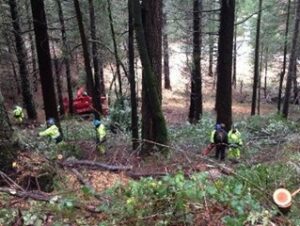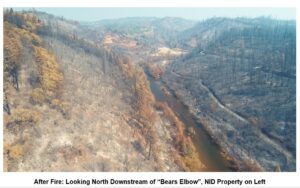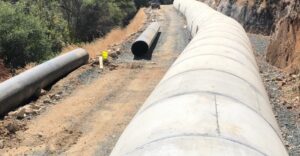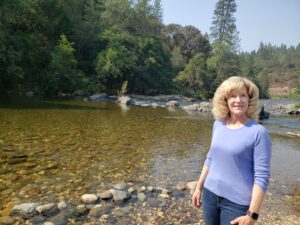Storm Updates

What a difference one mega storm can make! NID reservoir storage capacity is just under 280,000 acre feet (AF). On October 20, our reservoir storage measured 114,719 AF. On October 27, our reservoir storage measured 138,943 AF. This increase of over 24,000 AF is a great boon to the District and our customers! NID cut off all canal flows thus helping us maximize the benefits of the rain in storage. That was a lot of work for the NID staff. Let’s pray we continue to see precipitation.
The Bear River burn scar area survived the deluge in amazingly good shape with no major debris, down trees, ash or sediment found in the river. NID staff worked rapidly to treat about 85 acres (out of 100) that were on a slope of 40% or greater. PCWA and PG&E simultaneously worked on the other side of the river and had equally good results in protecting the river and the canal.
Scotts Flat and Rollins Reservoir Fire Forest Improvement Project

$981,000 grant from Sierra Nevada Conservancy for $145,000 grant from Cal Fire Forest Improvement Program to thin 300 acres at Scotts Flat and 103 acres at Rollins reservoir.
Wildfire is a natural occurrence, but it is also the single largest threat to the forest condition and long-term functionality of our watersheds. Forest management projects are essential for protecting the watersheds in our care. Projects include fire hazard mitigation and hazard tree removal, forest community improvement, and habitat restoration.
You might see NID staff at work around Scotts Flat and Rollins Reservoirs thinning forests and removing the underbrush. In a collaborative effort with CalFire, US Forest Service, and Sierra Conservancy we reduce the density of the forested area on and around NID land.
The River Fire Update
The River Fire, which scorched over 2,600 acres of the watershed of the Bear River in both Nevada and Placer counties, included approximately 320 acres of NID owned land. The Bear River is a key component of the District’s water conveyance system. Approximately 15,000 individuals (LOP and N. Auburn) receive treated water and 3,000

customers receive raw water downstream of this wildfire-impacted area.
Major concerns are hillside stability, trees in the river, sedimentation from hillside erosion and possible landslides. The preliminary estimate to secure the area and prevent further damage is approximately $3.5 milion.
The district is working collaboratively with the Placer County Water Agency, PG&E and other agencies and jurisdictions to mitigate the damage. See the staff report to the board meeting, August 25, 2021, entitled River Fire Update for further information. My heart goes out to all those who were directly effected by this tragedy and I can assure you that the District will do all that it can to prevent further damage.
This fire, so close to our community and NID infrastructure, reinforces the critical need to invest in forest management. Much of our infrastructure traverses areas that are at high risk of wildfires. As we begin work on NID’s strategic plan, which includes the Plan for Water, we will undoubtedly be considering our fire risks and strategies for addressing this critical issue.
The Bear River Siphon and Combie Phase I Canal

The Bear River Siphon spans the border of Nevada and Placer Counties. The Combie Phase I Canal and Bear River Siphon are the primary water conveyance mechanism from Combie Reservoir to NID’s downstream conveyance infrastructure for agriculture in southern Nevada and western Placer Counties. It also supplies some treated water in Lake of the Pines and North Auburn communities.
Installation of the 54-inch aerial siphon was completed in July 2018 and is now in service. Construction of the first phase of replacing the existing canal with a 96-inch reinforced concrete pipe was completed in April 2020. Construction of the second phase began in Fall 2020 and the last piece of pipeline was installed, and water flowing by March 2021. The Board awarded the construction contract with Steve P. Rados Inc. at the February 27, 2019 board meeting.
Water Consumption & the Drought
While our spring snowpack initially looked fairly good this year, the dry spring resulted in snowmelt being absorbed into the ground instead of creating expected runoff for our reservoirs. The NID Board enacted a stage 2 drought declaration this summer because of these conditions and also approved purchase of $700,000 of PG&E water to help buffer us from the reduced reservoir supply. The NID staff also went into high gear increasing time spent on managing canal flows and minimizing losses.
snowmelt being absorbed into the ground instead of creating expected runoff for our reservoirs. The NID Board enacted a stage 2 drought declaration this summer because of these conditions and also approved purchase of $700,000 of PG&E water to help buffer us from the reduced reservoir supply. The NID staff also went into high gear increasing time spent on managing canal flows and minimizing losses.
While the numbers are still being finalized for year-to-date results, we know that 134 raw water customers voluntarily reduced their water purchases. This resulted in a total water savings of 1,400 acre feet.
I was one of the customers who cut back. I reduced each of our two accounts by 40%. I modified my irrigation schedules and was pleasantly surprised that we were not negatively impacted by the reduced volume. I want to assure you that if you reduce your raw water purchase and should mandatory reductions be enacted, your baseline will be your original purchase amount.
In times of drought, NID staff monitor canals more closely to minimize loss and water flowing out the ends of canals. With almost 500 miles of canals, this entails a lot of extra work for NID staff. But their efforts paid off with an additional 6,800 acre feet of savings! So on the raw water side, we saved about 8,200 acre feet of water as compared to 2020.
On the treated water side, the dry spring resulted in higher use initially. However, the cry for conservation went out and for the months of July, August and September, water use was down 8% as compared to 2020, and in October, use was down 28%! I appreciate that our customers heard NID’s drought message and did their part to reduce water use.
Thank you!!
